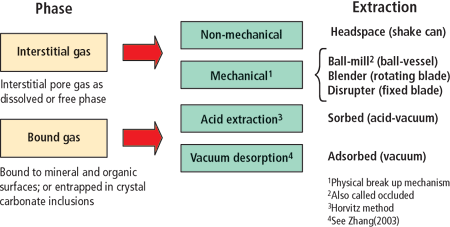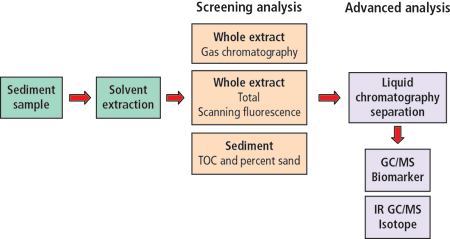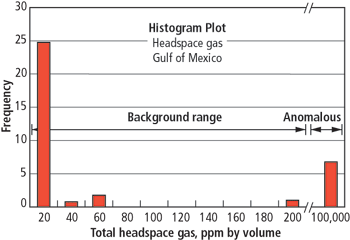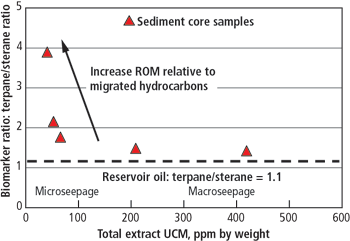Geochemical Exploration
Evaluating petroleum systems in frontier exploration areas using seabed geochemistry
Using an integrated approach, together with recognition of near-surface alteration, mixing and reworking, is the best way to use seabed geochemical data to reduce exploration risk.
Michael A. Abrams, Nicolas F. Dahdah and Eva Francu, Energy & Geoscience Institute, University of Utah, Salt Lake City, Utah
Seabed geochemical indications of migrated hydrocarbons provide critical information that mature source rock and effective migration are present. Hydrocarbon seepage can, in selected geological settings, also delineate subsurface petroleum accumulations and provide information on hydrocarbon charge and type. Surface geochemistry has been used for many years with varied success, attesting to the complex relationship between the surface and subsurface. Not all petroleum-bearing basins have a detectable surface signal. In addition, not all petroleum accumulations have a vertical, or nearly vertical, geochemical signature with the surface. Understanding controls on hydrocarbon movement from depth to surface, as well as near-surface processes that can alter, mask or confuse the surface geochemical signal, are critical for effective use of seabed seepage data in exploration.
SURFACE GEOCHEMISTRY CALIBRATION STUDY
A multi-year research study is underway at the University of Utah Energy & Geoscience Institute. The main objectives are to develop best practices for the collection, analysis and interpretation of seabed geochemical studies.1 The first phase of the Surface Geochemistry Calibration research project has focused on building a global calibration surface geochemical database using a variety of near-surface geochemical methods from many different geological settings. The calibration dataset includes surface geochemical surveys which have been successful in evaluating petroleum generation and entrapment, as well as those which have failed.
The global calibration dataset supports the assumption that all petroliferous basins exhibit a near-surface signal, but the signal is not always directly above an accumulation and/or detectable with conventional seepage-detection methods. Also, this surface geochemistry calibration study demonstrates the importance of well-founded interpretations. Many of the “failures” were due to poor interpretations. Proper interpretation of near-surface geochemical data requires differentiating background from anomalous populations, recent organic matter (ROM) input, transported hydrocarbon seepage, reworked source rock, in-situ or post-sampling bacterial alteration, field or laboratory contamination, and migration or sampling fractionation partitioning effects.2
Surface geochemical data provides a powerful empirical observation that must be integrated with geological and geophysical data. Seafloor geochemical calibration datasets help evaluate the utility of near-surface geochemical techniques within specific basinal settings and surface sediment conditions.
NEAR-SURFACE EXPRESSION OF MIGRATION
The rate and volume of hydrocarbon seepage to the surface modify the near-surface geochemical, geophysical, geological and biological responses. The near-surface expression of hydrocarbon migration is controlled by the interrelationships of sediment fill, tectonics (migration pathway), hydrocarbon generation (source and maturation), regional fluid flow (pressure regime and hydrodynamics) and near-surface processes.2 Relationships among near-surface hydrocarbon seepage and subsurface petroleum generation and entrapment are often complex, and their significance is commonly misinterpreted.2 The near-surface expression can be characterized by four parameters:
Seepage activity is defined as the qualitative expression of relative leakage rates.3 The seepage activity can be active, prolific, ongoing leakage from subsurface to near-surface sediments. Seepage activity can also be passive, slow, subtle leakage from subsurface to near-surface sediments. In areas of active seepage, hydrocarbon movement to the near surface is not always continuous, but can be episodic.4
Seepage type is defined as the concentration of migrating thermogenic hydrocarbon relative to in-situ material.3 This material includes recent organic matter (ROM) derived from pelagic, or reworked material from land based sources. Macroseepage3 usually refers to large concentrations of migrating hydrocarbons relative to ROM that are generally visible and related to bulk flow (Darcy). Microseepage refers to low concentrations of migrating hydrocarbons relative to ROM. Microseepage is not visible, but detectable with standard analytical procedures. The migration mechanism commonly proposed for microseepage is buoyancy of micro-bubbles.5
Migration focus is defined as the major direction of near-surface leakage relative to subsurface hydrocarbon generation and/or entrapment. The migration focus direction can be nearly vertical when there are major migration pathways such as faults and diapirs, or lateral, when displacement is controlled by regional basin fluid-flow dynamics.6 Some authors argue that, despite major lateral migration flow direction related to regional seals and key carrier beds, hydrocarbons also leak vertically.7
Near-surface disturbances are defined as near-surface processes that alter or block petroleum seepage signals.3 The Zone of Maximum Disturbance (ZMD)3 is a shallow near-surface zone where pore-water flushing, partitioning of migrated hydrocarbons between vapor, solute, and sorbed phases, and bacterial alteration and hydrocarbon generation have altered the migrating thermogenic hydrocarbon signatures beyond recognition. Additionally, shallow migration barriers such as hydrates, permafrost and cohesive shales can partially block migrating hydrocarbons.3
COLLECTION/ANALYSIS OF SEABED GEOCHEMICAL DATA
Collecting marine sediment cores for regional petroleum system evaluation has changed as the sampling, geophysical and navigation tools have become more powerful, and our understanding of migration and near-surface processes evolve. The early days of grid surveys with shallow cores (less than 1 m) and no real-time seismic have been replaced by sophisticated remote sensing and high-resolution geophysical acquisition to identify areas of petroleum leakage, real-time seismic to locate core sites during coring operations, deeper coring equipment to sample below the ZMD, and better navigation-subsurface locating devices to more accurately place the core body within the targeted feature.2
Multiple analytical procedures have been developed to remove migrated gases from sediments. The terminology used for each sediment gas extraction method generally refers to the physical removal process and not the phase. Migrated gases are found in: 1) the interstitial pore spaces as a free or dissolved phase; and 2) bound to mineral and/or organic surfaces, or entrapped in crystal inclusions, Fig. 1. The removal procedures range from simple shaking to mechanical break-up to chemical removal. Interstitial gases can be sampled by either non-mechanical headspace procedure8 or mechanical, such as the ball mill8, blender8 or disrupter.9 Bound gases can be sampled by two basic methods: acid extraction-digestion10 or vacuum.11
 |
Fig. 1. Sediment gas extraction procedures.
|
|
The most common screening procedures used for evaluating the presence of petroleum-related high-molecular-weight (HMW) compounds include gas chromatography (GC) and total scanning fluorescence (TSF), Fig. 2. Key compounds within this molecular range (C15 plus) include saturated hydrocarbons, unresolved complex mixtures (UCM), aromatics, polars or NSO (Nitrogen Sulfur Oxygen, also known as resins) and asphaltenes. A dried sediment sample is ground to a uniform size, a specific weight extracted with an organic solvent, and concentrated. The whole extract is analyzed by GC and TSF.
 |
Fig. 2. Analysis scheme for evaluating presence of petroleum- related high- molecular- weight (HMW) compounds.
|
|
Sediments containing moderate levels of upward-migrating, thermogenic high-molecular weight hydrocarbons display gas chromatograms characterized by an unresolved complex mixture (UCM), discernible C15 – C32 n-alkanes and isoprenoids, and an overprint of odd n-alkanes greater than C23 from terrigenous plant biowaxes.12 Total scanning fluorescence (TSF) detects and measures organic compounds containing one or more aromatic rings. Oil seepages have distinctive fluorescence fingerprints because they contain petroleum-related compounds with one or more aromatic rings and their alkyl homologues.13
When anomalous high-molecular-weight hydrocarbons are found with the above screening procedures, further molecular characterization is required. GC/MS, or gas chromatography/ mass spectrometry, provides detailed molecular information on biological markers. Biological markers are chemical compounds in reservoired oils and sediment extracts with the basic molecular structure that can be linked to a known biological precursor. Different organic source facies contain different assemblages of organisms (bacteria, algae, marine algae and higher plants). GC/MS biomarker data, in conjunction with non-biomarker parameters, resolve the organic source facies depositional environment, as well as the level of thermal maturity.
INTERPRETING SEABED GEOCHEMICAL DATA
Background versus anomalous. All sediments contain some background level of low-molecular-weight (LMW) and high-molecular-weight (HMW) hydrocarbons.2 Identifying background versus anomalous signatures for surface hydrocarbon measurements is complicated. A first step identifies the anomalous population, or populations (group of sampling sites with similar range of concentrations and/or eochemical measurements). A second determines their origin.
To properly identify an anomalous population that might be related to migrating hydrocarbons, parameters have to be chosen that best identify thermogenic seepage (gas or liquids). In addition, one must understand factors that control the specific geochemical parameter's magnitude and variability (sampling depth, location, sediment retention and analytical procedure). Lastly, we need to determine the best statistical or graphical approach to evaluate background versus anomalous populations.
Surface geochemical measurements rarely follow a normal distribution, but tend to a skewed log-normal distribution. The application of normal distribution descriptors such as mean, standard deviation and variance, has no statistical validity in a log-normal surface-geochemical dataset. Graphical data analysis is essential to examine the nature of sample distribution and identify multiple populations (background and anomalous). The most common graphical methods best suited for surface geochemical datasets include frequency histograms and cumulative frequency, Figs. 3a and 3b. Both methods provide the interpreter with a quantitative method to identify an anomalous population.
 |
 |
Fig. 3. Population distribution for sediment- headspace- extracted gases: background versus anomalous evaluation. Top: histogram. Bottom: cumulative frequency plot.
|
|
Recognizing thermogenic, migrated seabed gases. The molecular characteristics of surface sediment gases vary with type of gas present in the sediment (bacterial versus thermogenic), as well as with the gas extraction method.2 Unfortunately, hydrocarbon seepage found in many marine surveys are fractionated (in situ, during migration, or sampling process), partitioned (based on the properties of the hydrocarbon compounds and physical environment), bacterially altered and/or mixed (in-situ recent organic matter or generate hydrocarbons) rendering conventional reservoir interpretation schemes relatively useless in most areas with lower levels of seepage.
Natural gases are characterized using three analyses; gas composition (C1 – C5 and non-hydrocarbon components such as CO2), compound-specific carbon isotopic ratio (d13 Cn), and hydrogen isotopic ratio (dDCH4)14. Gas compositions and isotopic ratios depend on type and maturity of source.14 Alterations during migration or bacterial activity, and mixing will all affect the gas compositions and isotopic ratios.15
Recognizing thermogenic, migrated seabed liquid hydrocarbons. Oil seep hydrocarbon molecular interpretation requires a different approach than conventional oil-oil and oil-source correlation.2 Because recent organic matter (ROM) interferes, most conventional molecular characteristics and biomarker ratios deviate from true migrated value as the relative amounts of in situ ROM increase relative to the migrated hydrocarbon,19 Fig. 4.
 |
Fig. 4. Variation in biomarker parameters (terpane/ sterane) with changes in seepage intensity which correspond to changes in ROM influence. (Adapted from Abrams and Boettcher, 200019).
|
|
In addition, most seep extracts have undergone extensive bacterial alteration. The key is not to use the conventional interpretation methods designed to work with reservoired hydrocarbons. In the case of biomarkers, use lesser known, yet previously established biomarker parameters and substitute traditional biomarker ratios with novel ratios: extended tricyclics ratio, gammacerane diahopane index, and oleanane diahopane index.16 These novel ratios are less susceptible to interferences by ROM and biodegradation than found in the conventional ratios.
Integrating gas and liquid hydrocarbon data. Interpretation of surface geochemical data to evaluate migrated hydrocarbons first requires that all the hydrocarbon data, both oil and gas, be integrated. There are five general thermogenic hydrocarbon signatures:
Active (fresh) migrated thermogenic oil. Sediment samples have anomalous total hydrocarbon gas, with thermogenic gas signatures (elevated gas wetness and thermogenicd13Cn) and anomalously high, extracted high-molecular-weight (HMW) hydrocarbons with an undegraded thermogenic gas chromatogram and biomarker signatures.
Relict (passive) migrated thermogenic oil. Sediment samples contain slightly elevated ppm of total hydrocarbon gas, with thermogenic gas signatures (elevated gas wetness and thermogenicd13Cn) and anomalously high, extracted HMW hydrocarbons, with an altered (biodegraded), thermogenic gas chromatogram and biomarker signatures.
Relict migrated thermogenic oil with possible recharge. Sediment samples contain elevated ppm of total hydrocarbon gas with thermogenic gas signatures (elevated gas wetness and thermogenicd13Cn) and anomalously high, extracted HMW hydrocarbons with elevated UCM and n-alkanes present before n-C15 on extract gas chromatograms, as well as a strong thermogenic gas chromatogram and biomarker signatures.
Reworked signature. Mature reworked source rock in near-surface sediments can be confused with localized migrated hydrocarbon.17 Key geochemical characteristics that indicate reworked source rock include strong thermogenic signal with little or no ROM character; extract gas chromatograms with a full complement of normal paraffins (no evidence of bacterial alteration); relatively low levels of HMW hydrocarbons; little or no associated anomalous sediment gas; elevated total organic carbon (TOC); thermogenic seep signatures present in more than 30% to 40% of cores; and thermogenic signature present in both background and anomalous core sites.
Transported signature. Active large volume leakage (macroseepage) can be redistributed downdip to produce displaced hydrocarbon anomalies.18 The displaced hydrocarbon anomalies contain relatively low concentration thermogenic hydrocarbon signatures that are commonly misinterpreted as localized seepage.
Integrating seabed geochemical and geological data. Migration pathway analysis is critical in understanding the near-surface seepage in terms of petroleum system dynamics.2 Mapping thermogenic hydrocarbon seeps relative to potential cross-stratal migration pathways is one way to establish migration pathways to charge potential traps.18,19 Fluid-flow modeling, seismic attribute evaluation (mapping vertical noise trails) and surface morphology analysis are independent, non-geochemical ways to interpret near-surface geochemical anomalies and how they relate to hydrocarbon generation and entrapment.
Strata and cross-stratal fluid flow can be simulated by modeling programs. Water and hydrocarbon flows are modeled in two or three dimensions. These modeling programs depend on capillary entry pressure, pore-fluid dynamics (pore pressure and type), and regional hydrodynamics, which are largely unknown in most exploration areas. Nevertheless, the programs provide generalized understandings of major fluid-flow directions.
Single-trace attributes such as amplitude and frequency document acoustic anomalies, believed to be migrating or shallow-generated gas. Gas clouds, gas chimneys, bright spots, pull downs, wipeouts, gas-disturbed zones and blank-out zones are well-described in the literature.23 In 3D seismic cubes and sophisticated attribute analysis, these “noise” features can be used to map migration pathways to near surface. Methods such as the Chimney Cube20 highlight vertical noise trails in seismic data using assemblies of directive multi-trace seismic attributes and neural networking.
Leaking hydrocarbons and accumulated fluid-flow affects shallow sediments and seafloor character. What the seabed morphology will look like depends on several factors: rate and volume of leakage; type of migrating fluid (water, oil, and/or gas); sediment environment; timeframe (long-suspended versus short-term); and oceanographic conditions such as salinity, temperature and bottom water currents.21 Morphology features may be positive relief (constructive) or negative (destructive). Constructional features can result from slow accumulation of fluidized mud, hydrates (depending on pressure and temperature), and/or carbonate hardground (authigenic carbonate from bacterial activity); whereas depressions are produced from the explosive releases of fluids or the collapse of fluidized sediments.21 These seabed features are sometimes very large and easily recognized on seismic and sonar data.
Evaluating petroleum systems using seabed geochemistry. Seepage indicates a generating source is present. However, migrating hydrocarbons in near-surface sediments do not guarantee a nearby structure will be charged. Bolchert, et al.,22 found that many of the major seeps in the northern Gulf of Mexico are in areas with no fields or discoveries; and that many fields do not have a nearby surface seep. Thus, the significance of seepage at or near a potential prospect is not straightforward.
Thermogenic seepage in near-surface sediments at or near a prospect confirms the existence of a mature source rock. Tying a seep to a specific trap should include migration pathways analysis that uses seismic data and fluid-flow modeling. Predicting oil, condensate and gas using near-surface geochemistry is possible in a well-constrained seepage system with extensive local calibration data.23 Factors to remember when predicting reservoir charge using seepage molecular composition or concentrations include: near-vertical (little or no lateral migration) leakage, good communication with surface sediments and integrated examination of multiple geochemical data parameters.
Most surface geochemical surveys measure hydrocarbon gas concentration, given that petroleum is the main objective. Large concentrations of non-hydrocarbon gases, such as carbon dioxide and nitrogen, greatly affect production economics and are therefore equally important to predict. Nitrogen and carbon dioxide gas predictions usually involve temperature history analyses, since basins with large concentrations of reservoired carbon dioxide and nitrogen are often associated with elevated temperature gradients.24 A more empirical approach for non-hydrocarbon gas prediction is near-surface geochemistry. When concentrations of thermally derived non-hydrocarbon gases are elevated in near-surface sediments, there is a high risk of non-hydrocarbon gases in reservoirs.8
SUMMARY
Near-surface indications of migrating hydrocarbons provide critical information on source (organic matter type), maturation (organic maturity), migration (migration pathway delineation), and in selected geologic settings, prospect specific hydrocarbon charge (phase, composition and quality).
The interpretation of seabed geochemical data to evaluate key petroleum systems elements should include:
- Recognition of background versus migrated hydrocarbons
- Using an integrated, multiple parameter interpretation
- Recognition of problems with surface geochemical data
- Migration pathway analyses.
All petroliferous basins probably exhibit near-surface signals, but some geochemical signatures are not detectable with conventional methods. Relationships among near-surface hydrocarbon seepages and subsurface petroleum generation and entrapment are often complex. We need to recognize complexities, make sense of observations and reduce exploration risk by providing better basin assessment. Surface geochemistry is a tool that can greatly assist the explorationist in reducing charge risk. 
ACKNOWLEDGMENT
The authors thank the University of Utah Energy & Geoscience Institute's industry sponsors for funding the Surface Geochemistry Calibration research program.
LITERATURE CITED
1 Abrams, M. A., “Surface geochemical calibration research study: An example of research partnership between academia and industry,” New insights into petroleum geoscience research through collaboration between industry and academia. Geological Society, London, UK, May 8 – 9, 2002.
2 Abrams, M. A., M. P. Segall and S. G. Burtell, “Best practices for detecting, identifying, and characterizing near-surface migration of hydrocarbons within marine sediments,” Paper 13039, Offshore Technology Conference, Houston, Texas, Proceedings Volume OTC, 2001.
3 Abrams, M. A., “Geophysical and geochemical evidence for subsurface hydrocarbon leakage in the Bering Sea, Alaska,” Marine and Petroleum Geology Bulletin, V. 9, pp. 208 – 221, 1992.
4 Roberts, H. and R. S. Carney, “Evidence of episodic fluid, gas, and sediment venting on the northern Gulf of Mexico continental slope,” Economic Geology, V. 92, pp. 863 – 879, 1997.
5 Klusman, R. W and M. A. Saeed, “A comparison of light hydrocarbon microseepage mechanisms,” In: D. Schumacher and M. A. Abrams, eds., Hydrocarbon Migration and Its Near Surface Effects: American Association of Petroleum Geologists, Memoir No. 66, pp. 157-168, 1996.
6 Thrasher, J., A. J. Fleet, S. J. Hay, M. Hovland and S. Duppenbecker, “Understanding geology is the key to using seepage in exploration: The spectrum of seepage styles,” In: D. Schumacher and M. A. Abrams, eds., Hydrocarbon Migration and Its Near Surface Effects: American Association of Petroleum Geologists, Memoir No. 66, pp. 223 – 242, 1996.
7 Schumacher, D., and L. A. LeSchack, “Surface Exploration Case Histories: Applications of geochemistry, magnetics, and remote sensing,” American Association of Petroleum Geologists, Studies in Geology, No. 48, 2002.
8 Abrams, M. A., “Distribution of subsurface hydrocarbon seepage in near surface marine sediments,” In: D. Schumacher and M. A. Abrams, eds., Hydrocarbon Migration and Its Near Surface Effects: American Association of Petroleum Geologists, Memoir No. 66, pp. 1 – 14, 1996.
9 Abrams, M. A., “Significance of hydrocarbon seepage relative to petroleum generation and entrapment,” In: M. A. Abrams and J. Whelan, eds., Near-Surface Hydrocarbon Migration: Mechanisms and Seepage Rates: American Association of Petroleum Geologists, Studies in Geology, in press.
10 Horvitz, L., “Near surface evidence of hydrocarbon movement from depth,” In W. H. Roberts III and R. J. Cordell, eds., Problems of Petroleum Migration: American Association of Petroleum Geologists, Studies in Geology, No. 10, pp. 241 – 269, 1980.
11 Zhang, L, “Vacuum desoprtion of light hydrocarbons adsorbed on soil particles: A new method in geochemical exploration for petroleum,” American Association of Petroleum Geologists Bulletin, V. 87, pp. 89 – 97, 2003.
12 Brooks, J. M. and B. D. Carey, “Offshore surface geochemical exploration,” Oil and Gas Journal, V. 84, pp. 66 – 72, 1986.
13 Brooks, J. M., M. C. Kennicutt II, L. A. Bernard, G. J. Genoux and B. D. Carey, “Applications of total scanning fluorescence to exploration geochemistry,” Offshore Technology Paper, OTC4624, pp. 393 – 400, 1983.
14 Schoell, M., “Genetic characterization of natural gases,” American Association of Petroleum Geologists Bulletin, V. 67, pp. 2,225 – 2,238, 1983.
15 Abrams, M. A., “Interpretation of surface methane carbon isotopes extracted from surficial marine sediments for detection of subsurface hydrocarbons,” Association Petroleum Geochemical Exploration Bulletin, V. 5, pp. 139 – 166, 1989.
16 Holba, A. G. and B. J. Huizinga, “Depositional environment indicators: How to optimize your indicator to avoid the pitfalls of conventional indicators,” American Association of Petroleum Geologists Convention Abstracts, Annual AAPG Convention, Houston, Texas, March 10 – 13, 2002.
17 Piggott, N., M. A. Abrams, “Near Surface Coring in the Beaufort and Chukchi Seas, Alaska, In: D. Schumacher and M. A. Abrams, eds., Hydrocarbon Migration and Its Near Surface Effects: American Association of Petroleum Geologists, Memoir No. 66, pp. 385 – 400, 1996.
18 Cole, G., A. Yu, F. Peel R. Requejo, J. DeVay, J. Brooks, B. Bernard, J. Zumberge, and S. Brown, “Constraining source and charge risk in deepwater areas.” World Oil, October, V. 222, pp. 69 – 77, 2001.
19 Abrams, M. A., and S. B. Boettcher, “Mapping migration pathway using geophysical data, seabed core geochemistry, and submersible observations in the central Gulf of Mexico,” American Association of Petroleum Geologists Convention Abstracts, Annual AAPG Convention, New Orleans, Louisiana, April 16 – 19, 2000.
20 Aminzadeh, F., Groot, P. D., Berge, T., Oldenziel, T., and Ligtenberg, H., “Determining Migration path from seismically derived gas chimney,” In: Near-Surface Hydrocarbon Migration: Mechanisms and Seepage Rates, American Association of Petroleum Geologists Hedberg Conference, Vancouver, BC, Canada, April 7 – 10, 2002.
21 Hovland, M. and A. G. Judd, “Seabed Pochmarks and Seepage,” Graham and Trotman, London, p. 293, 1988.
22 Bolchert, G., P. Weimer, and B. C. McBride, “Structural and straigraphic controls on petroleum seeps, Green Canyon and Ewing Bank, Northern Gulf of Mexico: Implications for Petroleum Migration,” Gulf Coast Association of Geological Societies, Transactions, Volume I, pp. 65 – 74, 2000.
23 Schumacher, D., and M. A. Abrams, editors, “Hydrocarbon migration and its near surface effects,” American Association of Petroleum Geologists, Memoir No. 66, 1996.
24 Giggenbach, W. F., “Relative importance of thermodynamic and kinetic processes in governing the chemical and isotopic composition of carbon gases in high heatflow sedimentary basins,” Geochimica et Cosmochimica Acta, V. 61, No. 17, pp. 3763 – 3785, 1997.
THE AUTHORS
|
 |
Michael Abrams is manager of petroleum geochemistry and senior research scientist for the Energy & Geoscience Institute at the University of Utah. Prior to working for the University, he was managing director for Hydrocarbon Systems Evaluation and senior research geochemist for Exxon Production Research Co. He has authored numerous papers related to surface geochemistry and petroleum geochemistry and, along with Deet Schumacher, is co-editor of AAPG Memoir 66 Hydrocarbon Migration and Its Near Surface Expression. Abrams attended the University of Rochester, George Washington University, and University of Southern California.
|
 |
Nicolas F. Dahdah is manager of the Energy & Geoscience Institute Geochemistry Laboratory at the University of Utah. His research interests are in oil and source rock geochemistry, high temperature gas chromatography, and high-resolution C7 analysis. He has co-authored several papers on high temperature gas chromatography and is working on the industry sponsored surface geochemistry calibration research project. He attended the Southeast Missouri State University and University of South Carolina.
|
 |
Dr. Eva Francu is a research scientist with the Energy & Geoscience Institute at the University of Utah. Prior to working at the University of Utah, she was a research scientist with the Czech Geological Survey, where her main topics of research included petroleum geochemistry, organic petrology, clay mineralogy and basin analysis. She completed her PhD at the Masaryk University in Brno Czech Republic in 2000.
|
|










